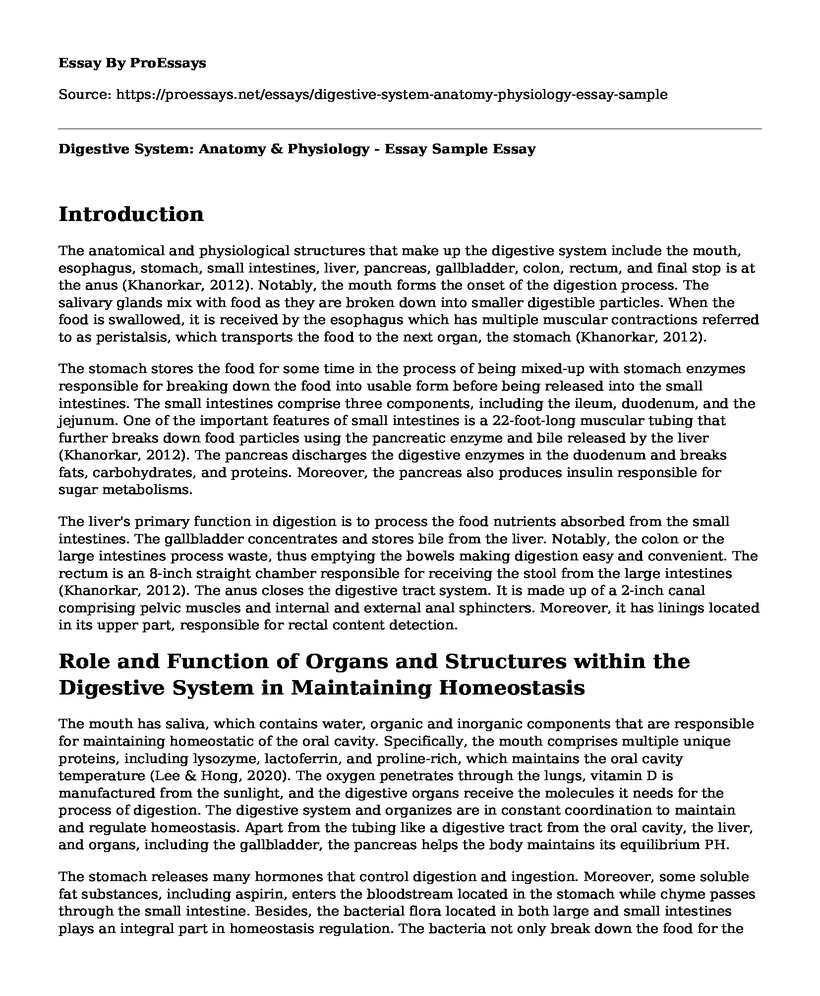Introduction
The anatomical and physiological structures that make up the digestive system include the mouth, esophagus, stomach, small intestines, liver, pancreas, gallbladder, colon, rectum, and final stop is at the anus (Khanorkar, 2012). Notably, the mouth forms the onset of the digestion process. The salivary glands mix with food as they are broken down into smaller digestible particles. When the food is swallowed, it is received by the esophagus which has multiple muscular contractions referred to as peristalsis, which transports the food to the next organ, the stomach (Khanorkar, 2012).
The stomach stores the food for some time in the process of being mixed-up with stomach enzymes responsible for breaking down the food into usable form before being released into the small intestines. The small intestines comprise three components, including the ileum, duodenum, and the jejunum. One of the important features of small intestines is a 22-foot-long muscular tubing that further breaks down food particles using the pancreatic enzyme and bile released by the liver (Khanorkar, 2012). The pancreas discharges the digestive enzymes in the duodenum and breaks fats, carbohydrates, and proteins. Moreover, the pancreas also produces insulin responsible for sugar metabolisms.
The liver's primary function in digestion is to process the food nutrients absorbed from the small intestines. The gallbladder concentrates and stores bile from the liver. Notably, the colon or the large intestines process waste, thus emptying the bowels making digestion easy and convenient. The rectum is an 8-inch straight chamber responsible for receiving the stool from the large intestines (Khanorkar, 2012). The anus closes the digestive tract system. It is made up of a 2-inch canal comprising pelvic muscles and internal and external anal sphincters. Moreover, it has linings located in its upper part, responsible for rectal content detection.
Role and Function of Organs and Structures within the Digestive System in Maintaining Homeostasis
The mouth has saliva, which contains water, organic and inorganic components that are responsible for maintaining homeostatic of the oral cavity. Specifically, the mouth comprises multiple unique proteins, including lysozyme, lactoferrin, and proline-rich, which maintains the oral cavity temperature (Lee & Hong, 2020). The oxygen penetrates through the lungs, vitamin D is manufactured from the sunlight, and the digestive organs receive the molecules it needs for the process of digestion. The digestive system and organizes are in constant coordination to maintain and regulate homeostasis. Apart from the tubing like a digestive tract from the oral cavity, the liver, and organs, including the gallbladder, the pancreas helps the body maintains its equilibrium PH.
The stomach releases many hormones that control digestion and ingestion. Moreover, some soluble fat substances, including aspirin, enters the bloodstream located in the stomach while chyme passes through the small intestine. Besides, the bacterial flora located in both large and small intestines plays an integral part in homeostasis regulation. The bacteria not only break down the food for the nutrients to be absorbed but also releases vitamins, including vitamin K, biotin, and regulate other bacteria capable of interfering with the PH from entering the body (Lee & Hong, 2020). The liver produces bile salt that travels through the intestine to blend fats, thus making it easier for absorption and digestion. Moreover, the concentration and storage of the bile salt take place in the gallbladder and penetrates the intestines through the bile duct. The digestive bicarbonate and enzymes are produced by the pancreas, in which the bicarbonate assist in the neutralization of acidic contents in the chyme passing from the stomach to the small intestines. An increase in the pH provides an effective environment for the functions of the digestive enzymes efficiently (Lee & Hong, 2020).
References
Khanorkar, S. (2012). Physiological anatomy and innervations of digestive system. Insights in Physiology, 139-139. Doi.org/10.5005/jp/books/11552_24
Lee, D., & Hong, J. H. (2020). The fundamental role of bicarbonate transporters and associated carbonic Anhydrase enzymes in maintaining ion and pH homeostasis in non-secretory organs. International Journal of Molecular Sciences, 21(1), 339. Doi.org/10.3390/ijms21010339
Cite this page
Digestive System: Anatomy & Physiology - Essay Sample. (2023, Aug 01). Retrieved from https://proessays.net/essays/digestive-system-anatomy-physiology-essay-sample
If you are the original author of this essay and no longer wish to have it published on the ProEssays website, please click below to request its removal:
- Essay Example on Nurses' Ethics and Social Determinants of Health: Addressing Health Inequity
- Essay on Inclusive Education: Achieving Social & Academic Success for Children With Disabilities
- Smoking Cessation: Impact of 5A's Tool Counseling Intervention - Research Paper
- Essay Example on Modern Birth Control: Hormonal Contraception and its Benefits
- Essay Example on US vs Canada: Comparing Healthcare Systems
- Obesity: A Growing Health Issue in the US - Essay Sample
- Planned Parenthood of Southeast Pennsylvania v Casey







